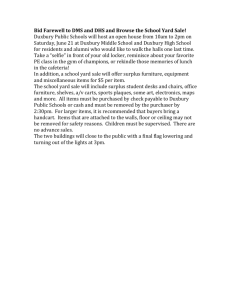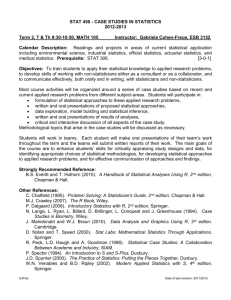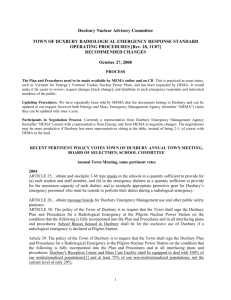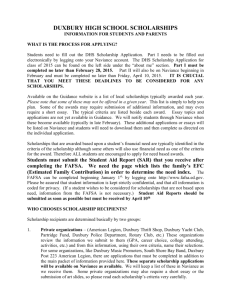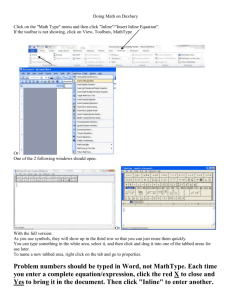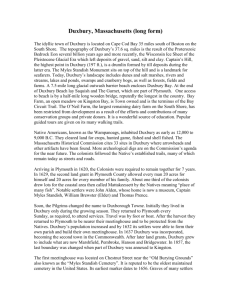Photographs - olddocsnewtech
advertisement
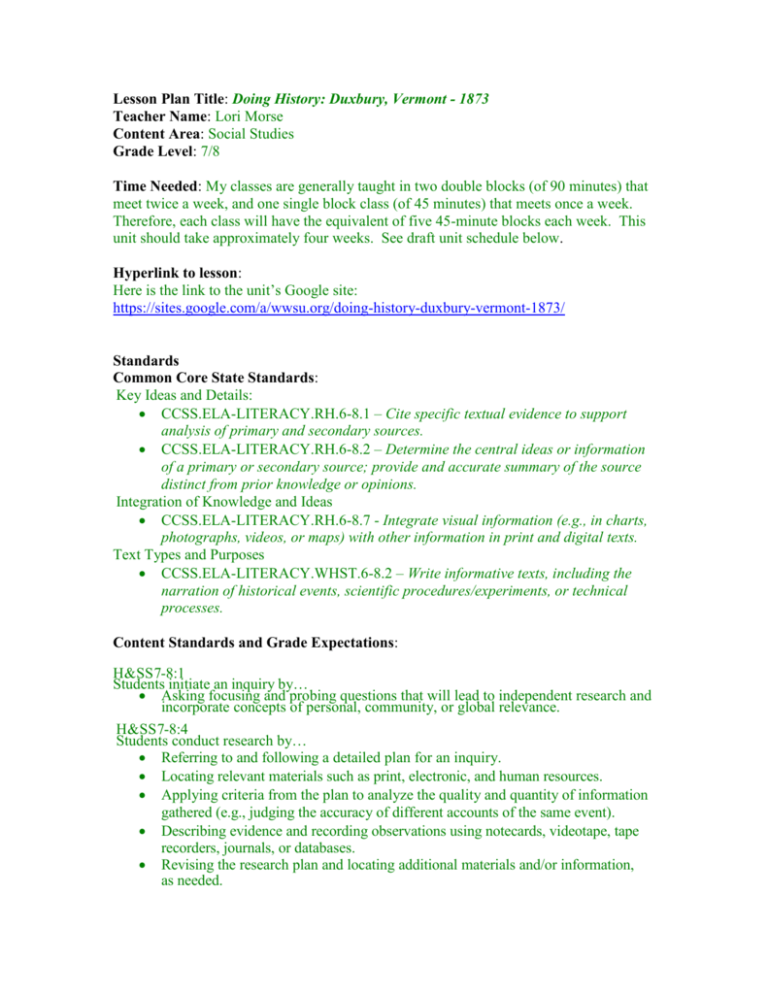
Lesson Plan Title: Doing History: Duxbury, Vermont - 1873 Teacher Name: Lori Morse Content Area: Social Studies Grade Level: 7/8 Time Needed: My classes are generally taught in two double blocks (of 90 minutes) that meet twice a week, and one single block class (of 45 minutes) that meets once a week. Therefore, each class will have the equivalent of five 45-minute blocks each week. This unit should take approximately four weeks. See draft unit schedule below. Hyperlink to lesson: Here is the link to the unit’s Google site: https://sites.google.com/a/wwsu.org/doing-history-duxbury-vermont-1873/ Standards Common Core State Standards: Key Ideas and Details: CCSS.ELA-LITERACY.RH.6-8.1 – Cite specific textual evidence to support analysis of primary and secondary sources. CCSS.ELA-LITERACY.RH.6-8.2 – Determine the central ideas or information of a primary or secondary source; provide and accurate summary of the source distinct from prior knowledge or opinions. Integration of Knowledge and Ideas CCSS.ELA-LITERACY.RH.6-8.7 - Integrate visual information (e.g., in charts, photographs, videos, or maps) with other information in print and digital texts. Text Types and Purposes CCSS.ELA-LITERACY.WHST.6-8.2 – Write informative texts, including the narration of historical events, scientific procedures/experiments, or technical processes. Content Standards and Grade Expectations: H&SS7-8:1 Students initiate an inquiry by… Asking focusing and probing questions that will lead to independent research and incorporate concepts of personal, community, or global relevance. H&SS7-8:4 Students conduct research by… Referring to and following a detailed plan for an inquiry. Locating relevant materials such as print, electronic, and human resources. Applying criteria from the plan to analyze the quality and quantity of information gathered (e.g., judging the accuracy of different accounts of the same event). Describing evidence and recording observations using notecards, videotape, tape recorders, journals, or databases. Revising the research plan and locating additional materials and/or information, as needed. Citing sources. H&SS7-8:7 Students communicate their findings by… Developing and giving oral, written, or visual presentations for various audiences. Soliciting and responding to feedback. Pointing out possibilities for continued or further research. Overview: During this unit, students will investigate the town of Duxbury, Vermont in the year 1873. They will use a map of the town that shows the nine school districts that existed at the time, as well as the names of the families living in each district. Students will examine U.S. Census records of 1870 and 1880, along with other available resources (primary and secondary) in order to tell the story of life in town during that time period. The final product created will be a website with links to the following for each district: a digital map with tags (Thinglink) images of the land and buildings (current photographs as well as those found on the UVM Landscape Change website) stories of the people living there (GoogleDocs) an infographic that illustrates the demographics of their studied school district (Easel.ly) *see the attached student handout describing the project Goal: This unit will focus on both knowledge and skills. Students will gain knowledge about the town in which their school is located, while also practicing the skills that are necessary to be historians. They will analyze primary sources (maps, census records, birth/death/marriage records, etc.). They will use inquiry to discover how historians use primary and secondary sources to put together the pieces of the historic puzzle. Students will then share their knowledge with the greater school community by way of a public website. Objectives: Throughout the unit, students will be assessed on the following: Identification of sources – primary and secondary Text and image analysis Designing and conducting research Presentation of learning Collaboration Essential Questions: Essential Questions of the Unit What are primary sources and what can be learned from them? What were the demographics of Duxbury in the year 1873? How were Duxbury school districts organized in 1873? Why? Prior Knowledge Students are aware of the topography of the land and the recent history of the town of Duxbury. Students will have had some experience with the identification and analysis of historical sources. From a prior unit, students will understand the basics of genealogy and how to organize a family tree. Assessment: Formative Assessments Groups will be expected to begin the unit by creating a research plan that lists the steps that need to be done to complete the project. They will identify who will be responsible for each step. Students will update the plan at the end of each class explaining the work they completed that day and their next steps. This will serve as their personal, reflective formative assessment. In addition, I will assess the following throughout the unit: Map analysis using Thinglink Understanding of U.S. Census records Identification and analysis of resources Effective and appropriate use of technology Summative Assessment Students will be assessed on their work throughout the unit and their individual contribution to the final team website. (Rubric attached) Resources: 1873 Beers Atlas of Washington County (digital copy from VHS Collection) 1870 and 1880 U.S. Census - from www.ancestry.com (students can use my account to search) and/or Vermont Historical Society http://vermonthistory.org/educate/onlineresources/vermont-census-records Town of Duxbury Vital Records - Found at Duxbury Town Clerk’s Office, Duxbury Historical Society, and/or the Vermont State Archives: https://www.sec.state.vt.us/archives-records/vital-records.aspx birth death marriage Example of marriage record: Marriage certificate of Harvey Morse & Grace Batchelder (my grandparents) http://interactive.ancestry.com/1606/31394_20746901097/1254313?backurl=http%3a%2f%2fsearch.ancestry.com%2fcgibin%2fsse.dll%3fdb%3dVermontMarriages%26h%3d1254313%26indiv%3dtry%26o_vc%3dRe cord%253aOtherRecord%26rhSource%3d1606&ssrc=&backlabel=ReturnRecord Land Records deeds taxes Photographs houses/schools gravestones topography Photograph of Tiberius Morse gravestone (my great, great, great uncle) Located in Phillips Cemetery, Route 100 Duxbury, VT, photographed by Lori Morse – May 2013 Interviews – I will try to identify one local historian to mentor each of the nine groups of students. Technology: Students will have access to laptops throughout the unit. We will use these to view and analyze sources, such as the 1873 map of Duxbury, U.S. Census records, and vital records found on Ancestry.com. In addition, students will use the laptops to collaborate with their district groups as they create the final product/website. Other classroom technology used during the unit: amplification device for two students have hearing loss document camera and projector Materials: Primary source analysis tool (from Library of Congress): http://www.loc.gov/teachers/usingprimarysources/resources/Primary_Source_Analysis_T ool.pdf Materials found at end of this unit plan: Student handout Group research planning sheet Individual rubric for final project Preparation: Since I will be teaching this unit in the spring of the year, I will have already spent 8 months with my students. I will have assessed their needs, interests, and prior learning by this time. If I were teaching this to a group that I didn’t know as well, I would want to know where students were in relation to the following: Reading level Writing skills (basic narrative structure & writing conventions) Technology skills related to Google Docs and Google Sites Spatial ability (for understanding of contour map) Collaboration skills Management: Students will be divided into nine groups – one for each of the nine school districts in Duxbury at the time being studied. The groups will be made up of students in each of the four traveling groups that I teach. (With approximately 72 students on the team, each group will consist of eight students – two from each traveling group.) Therefore, students will need to collaborate virtually (using GoogleDocs) in order to complete their work. Most work will take place in the classroom, with laptops or iPads. (We may use the school’s wired lab when necessary.) We may also take an occasional field trip to the Duxbury Town Clerk’s office and/or the local cemeteries. Instruction and Activities: See draft of unit schedule below Differentiation: Since there will be a variety of tasks and responsibilities, students will be able to focus on a part of the project that best fits their learning style. (For example: writing, photography, technology, etc.) All pieces will be necessary for the completion of the final product. Students who need assistance will have access to a classroom para-educator. Lesson Plan Title: Doing History: Duxbury, Vermont - 1873 Teacher Name: Lori Morse – Crossett Brook Middle School Content Area: Social Studies Grade Level: 7/8 Unit Schedule – Draft The general structure of the four-week unit will be the following: Week 1 = 1873 map; Thinglink; Unit introduction; U.S. Census Week 2 = U.S. Census; Duxbury vital records; Cemeteries; Begin family stories Week 3 = Topography & location; Photographs; Continue family stories; Easel.ly Week 4 = Website creation and linking; Reflection Week 1, Day 1 (double block) 1. Show students 1873 map. Have them use Thinglink to ask questions/make comments on it. (Students will need to have Thinglink accounts.) Probable questions/comments What are the different colored sections? When was this map made? What was the population of the town? Where is the current location of our school – CBMS? What are the names in each section? 2. Explain the source of the map. 3. Introduce the unit and culminating project. Share unit handout with students. 4. Put students in groups and assign the districts. A student in each group should open a Google doc and share with their group members (and me). Since groups will be made of students from all four traveling groups these Google docs will be used for collaboration. 5. Have students study their district map and make a list of all the identified places (names of families, school, businesses, other). Week 1, Days 2, 3 (double block & single block) 6. As a class, look at a page from the 1870 U.S. Census for Duxbury, and do a close read of it. Discuss the questions that were asked on this census, and talk about the purpose of each. (Discuss historical context) 7. Genealogy mini-lesson 8. Groups of students will study the 1870 and 1880 U.S. Census records and attempt to identify the families living in their districts. Model for them how to make, test, and modify a hypothesis as it relates to historical research. Week 2, Days 4,5, 6 (2 double blocks & 1 single block) 9. Students will use town and state records (vital, land, etc.) to learn more about the families in their districts. 10. Student groups will write a minimum of three brief family histories of the people living in their districts. These histories will be written on a GoogleDoc that will be linked to their district page on the unit website. Week 3, Days 7 & 8 (2 double blocks) 11. Students should continue to work on the family histories that will be on their district page on the unit website. 12. Groups will be responsible for writing a brief narrative about the land in their district (location, topography, etc.). These will be on their district pages on the unit website. Photographs should accompany these written descriptions. Week 3, Day 9 (single block) 13. Easel.ly mini-lesson. Each district group will use Easel.ly to create an infographic that illustrates some of the demographics of the district. This will be linked to the district’s page on the unit website. Week 4, Days 10, 11, 13 (2 double blocks, 1 single block) 14. Website creation – Entire week We will use Google sites to create a team website for this unit. Each school district group will have one page that is linked to the home page. At the beginning of the week we will look at the website and begin to create the pages for each district. The rest of the week will be spent working on the creation of the pages and the links. (It will be for necessary for the teacher to create the website and design the homepage before this stage of the unit.) At the end of the unit, if time allows, it would be helpful to give students time to look at the web pages for the other districts. Facilitate a discussion of the similarities and differences between districts. (Student Handout) Prodigy Team Social Studies Spring 2015 Being Historians Duxbury, Vermont – 1873 Would you be surprised to know that, at one point in history, the small town of Duxbury, Vermont was home to nine schools, each educating students from first to eighth grade? Why? Where were the schools located? What was the connection between the physical geography of the town and the schools? Who were the children who attended those schools? What were their families like? During this unit, we will be investigating all of those questions, and more, as we try to paint a picture of Duxbury in the year 1873. To do this, we will study the following: The physical geography of the land The nine separate school districts and the schools located n each The demographics of the town – Who were the people living in each school district? YOUR TASK: You will be working in small groups, acting as historians, to study one of the nine school districts and produce a digital annotated map of your assigned district. In order to do this, we will be using a number of primary sources, including: Map of Duxbury in 1873 from the Beers Atlas of Washington County U.S. Census records of 1870 and 1880 Town of Duxbury vital records (birth, death, marriage); land and tax records Photographs Cemeteries Products to be Created Prodigy Team social studies students will contribute to a team website that we will use to communicate our learning during this unit. Your group will study your assigned school district and create (and add to the team website) the following: An interactive map of your district; Brief genealogical histories of at least three (3) of the families that lived in your district; Photographs of your district through time; Information about the school and businesses located in your district; An infographic illustrating details about the people living in your district. As you can see, much of our work in this unit will include a technology piece. We will learn how to do all of this in class. In order for your group to be successful, you will need to collaborate extensively and effectively. (Group Planning/Reflection Sheet) Prodigy Team Social Studies Duxbury History Unit Group Research Planning Sheet District ____________________ Please update this sheet at the end of each class period. Task – Steps – Whose Status? Next Steps Be Specific Be Specific Responsibility? Make sure to leave this planning sheet in the group folder in the classroom. (Final Individual Work Rubric) Prodigy Team Social Studies Doing History: Duxbury, Vermont – 1873 Final Project Individual Work Rubric Criteria Points Possible Points Earned Student Teacher Work Completion 20 _________ _________ Did you take on a fair share of your group’s work? Did you do only what was asked of you or did you do more? Did you complete all of you work on time? Was the work all done to the very best of your ability? Responsibility to Group 20 _________ _________ Did you work as an effective group member? Were you respectful to all group members? Did you make a real effort to communicate with all group members? Were you a leader in your group, and on the team as a whole? Knowledge Gained 20 _________ __________ Is it clear that you gained knowledge and skills during this unit? Do you know more about the history of Duxbury than you did before this unit began? Are you able to identify and work with primary sources? Did you learn (or increase your knowledge of) technology tools? Presentation of Learning 20 __________ __________ Have you effectively used the class website to show your learning? Are your contributions to the website complete, accurate, and appropriate? Does all written work use correct spelling & GUM? Have you used apt historical vocabulary? Reflection 20 _________ _________ In the space below, please reflect upon your work in this unit. Talk specifically about each of the parts of the unit: 1) Primary source analysis and research; 2) Creation of products for the website (family histories, photographs and land information, infographic, etc.); & 3) Website creation. Go into detail about your contribution to your group and your functioning as a group member. In addition, tell me specifically what you learned during this unit, particularly in regards to the use of primary sources in the study of history. TOTAL 100 _________ ___________
